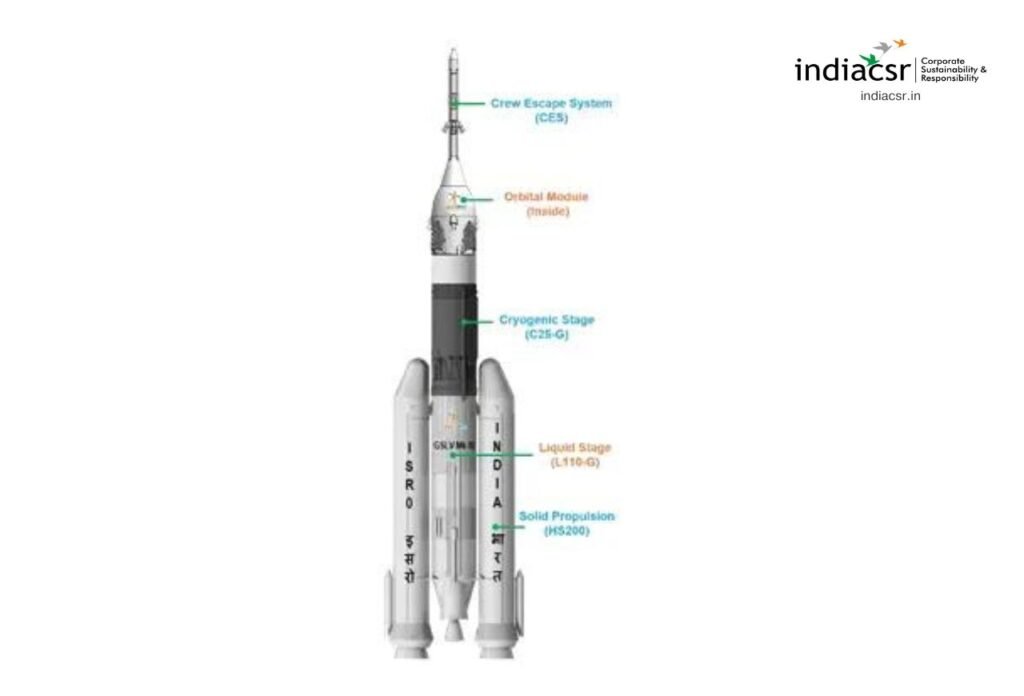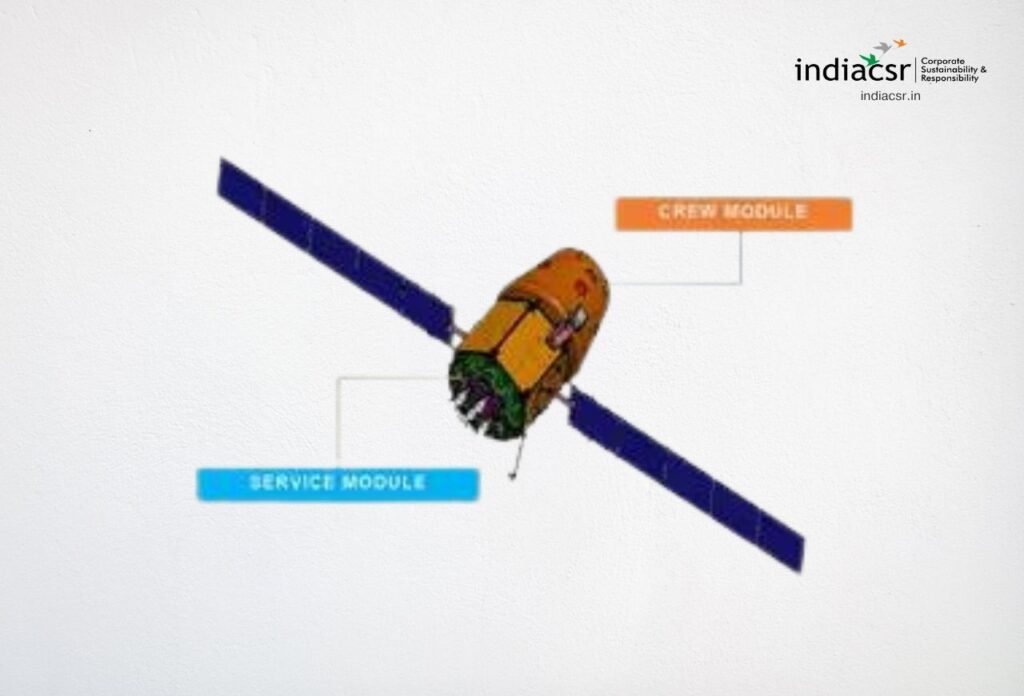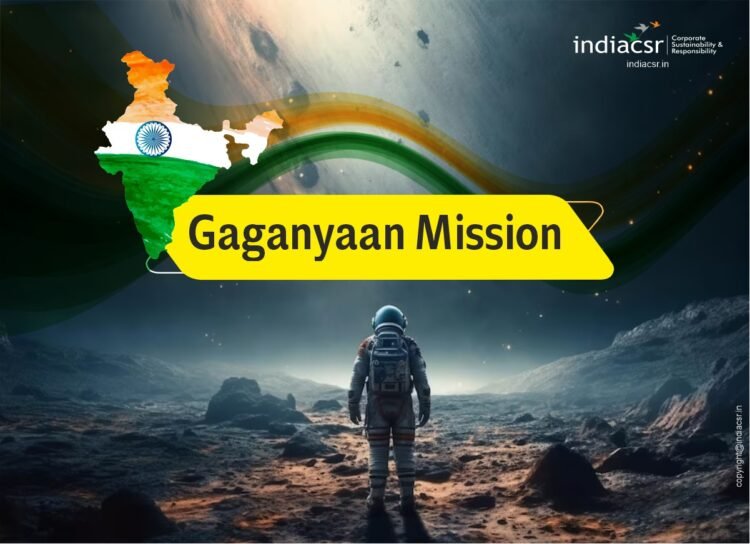The Gaganyaan Mission is a project by the Indian Space Research Organisation (ISRO) to send a three-member crew to space for a period of up to seven days by 2025. The mission aims to demonstrate India’s capability to undertake human spaceflight and lay the foundation for a sustained Indian human space exploration programme. The mission will use a modified version of ISRO’s LVM3 rocket to launch a crew module and a service module into a low Earth orbit of 400 km. The crew module will provide a habitable environment for the astronauts, while the service module will provide support functions such as power, propulsion, and communication. The mission will also involve various technologies such as crew escape system, life support system, and re-entry system. The Gaganyaan Mission will make India the fourth country in the world, after the US, Russia, and China, to have human space flight capability.
What is the Gaganyaan Mission
The Gaganyaan Mission is India’s first human space flight programme, which aims to send three astronauts to an orbit of 400 km for a three-day mission and bring them back safely to Earth1. The mission is scheduled to take place in 2025, after two unmanned test flights in 20242. Prime Minister Narendra Modi announced the names of four Air Force pilots who have been shortlisted to travel on the Gaganyaan Mission on Tuesday. They are Group Captain Prashanth Balakrishnan Nair, Group Captain Ajit Krishnan, Group Captain Angad Pratap and Wing Commander Shubhanshu Shukla. The Gaganyaan Mission is a landmark achievement for India, as it will make it the fourth country to send a human into space after the Soviet Union, the US and China. The mission will also enable India to conduct various scientific experiments and explore the potential of space for the benefit of humanity
Story Behind Word ‘Gaganayan’
India often chooses cool names for its space missions, either inspired by historical moments or digging deep into the ancient language of Sanskrit. “Gaganayaan” falls in the second category, translating to “Celestial Vehicle” – pretty cool, right?
Gaganyaan
- Gagana (Sanskrit: गगन) – Means “sky,” “celestial,” or “atmosphere.”
- Yāna (Sanskrit: यान) – Means “vehicle,” “craft,” or “vessel.”
- Together, the word “Gaganyaan” translates to “sky vehicle” or “celestial craft.”
Gaganyaan: India’s Space Mission
Gaganyaan is India’s first crewed orbital spacecraft project. It’s a major milestone for the Indian Space Research Organisation (ISRO). The key goals of the Gaganyaan mission are:
- Demonstrate India’s ability to send humans to Low Earth Orbit (LEO).
- Lay a strong foundation for future, more ambitious, sustained human space exploration programs.
***
Philosophy Behind word ‘Gaganayan’
While there isn’t an officially stated “philosophy” behind the name “Gaganayaan,” we can infer some possible ideas based on its meaning and India’s approach to naming space missions:
1. Connection to the Universe: Choosing a Sanskrit word with roots in “sky” and “vehicle” suggests an intent to connect the mission to the vastness of the universe. It reflects India’s aspirations in space exploration and its desire to reach new heights.
2. Continuity with Tradition: India often names its space missions after mythological figures, historical events, or significant scientific discoveries. “Gaganayaan” continues this tradition of drawing inspiration from its rich heritage.
3. Simple and Evocative: The name is short, easy to pronounce, and carries a powerful image. This accessibility resonates with the public and creates a sense of national pride associated with the mission.
4. Reflecting India’s Identity: Choosing a Sanskrit word connects the mission to India’s ancient culture and intellectual tradition. It sends a message of cultural pride and demonstrates India’s contribution to the global scientific endeavor.
***
Gaganyaan Project
The Gaganyaan project aims to showcase India’s capability in human spaceflight by sending a three-member crew to a 400 km orbit for a three-day mission, followed by a safe return to Earth, landing in the waters off the coast of India.
This ambitious endeavor is realized through a carefully crafted strategy that leverages the domestic expertise and experience of the Indian industry, the intellectual prowess of India’s academic and research institutions, and the most advanced technologies from international partners. Essential to the Gaganyaan mission are the development of several critical technologies, including a human-rated launch vehicle to safely transport the crew into space, a Life Support System to maintain Earth-like conditions for the crew in orbit, provisions for crew emergency escape, and comprehensive crew management plans covering training, recovery, and rehabilitation.
To ensure the mission’s success, a series of precursor missions are set to demonstrate the readiness of these technologies. These preliminary missions encompass the Integrated Air Drop Test (IADT), the Pad Abort Test (PAT), and Test Vehicle (TV) flights. The safety and reliability of all systems will be thoroughly verified through unmanned missions before proceeding with the manned mission.
Human rated LVM3 – HLVM3
The LVM3 rocket, ISRO’s trusted and proven heavy-lift launcher, has been selected for the Gaganyaan mission. This rocket features a combination of solid, liquid, and cryogenic stages. To fulfill the stringent requirements of human spaceflight, all systems within the LVM3 have been adapted and upgraded, resulting in the Human Rated LVM3 (HLVM3). This enhanced version of the rocket is designed to carry the Orbital Module into a targeted Low Earth Orbit at 400 km.

The HLVM3 is equipped with a Crew Escape System (CES), which is powered by a series of rapid-activation, high burn rate solid motors. This system is designed to ensure the Crew Module, along with its occupants, is quickly moved to a safe distance from any potential dangers that could arise either on the launch pad or during the rocket’s ascent.
Orbital Module
The Orbital Module (OM) intended for Earth orbit is composed of a Crew Module (CM) and a Service Module (SM). The OM is furnished with advanced avionics systems, incorporating sufficient redundancy to prioritize human safety.
The CM serves as a habitable space in space for the crew, creating an Earth-like environment. It features a double-walled construction, consisting of a pressurized metallic Inner Structure and an unpressurized External Structure equipped with a Thermal Protection System (TPS). Within the CM, crucial components such as crew interfaces, human-centric products, life support systems, avionics, and deceleration systems are housed. Additionally, it is designed for re-entry to ensure the safety of the crew during descent until touchdown.

The SM is dedicated to providing essential support to the CM while in orbit. This unpressurized structure incorporates a thermal system, propulsion system, power systems, avionics systems, and deployment mechanisms. The SM plays a crucial role in maintaining the functionality and support required for the successful operation of the entire Orbital Module.
***
Meet the Pioneers: Astronauts for Gaganyaan
Prime Minister Narendra Modi has announced the names of the four astronauts for India’s first human space flight mission, Gaganyaan. The astronauts are:
1. Group Captain Prasanth Balakrishnan Nair

- Born in 1976 in Nenmara, Kerala.
- Commissioned in the fighter stream of the IAF in December 1998.
- A Sukhoi fighter pilot and a recipient of the ‘Sword of Honour’.
- Has flown a variety of aircraft, including Su-30 MKI, MiG-21, MiG-29, Hawk, Dornier, and An-32.
- Has approximately 3,000 hrs of flying experience.
- Married to Malayalam actress Lena.
2. Group Captain Ajit Krishnan

- An alumnus of the National Defence Academy.
- A recipient of the President’s Gold Medal and Sword of Honour.
- Has around 2,900 hours of flying time.
3. Group Captain Angad Pratap

- Commissioned on December 18, 2004, in the fighter stream of IAF.
- A Flying Instructor and a Test Pilot with approximately 2,000 hours of flying experience.
- Has flown a variety of aircraft including Su-30 MKI, MiG-21, MiG-29, Jaguar, BAe Hawk, Dornier, and An-32.
4. Wing Commander Shubhanshu Shukla

- Born in Lucknow.
- Commissioned in the Indian Air Force on June 17, 2006, in the fighter stream.
- A Fighter Combat Leader and a Test Pilot with around 2,000 hours of flying experience.
These Indian Air Force officers have had extensive experience as test pilots and are currently in training for the mission. The announcement was made at the Vikram Sarabhai Space Centre in Thumba, Kerala. The first unmanned Gaganyaan-1 mission, a test flight to check the technology readiness for the final mission, is scheduled to take off by the end of 2024. The manned mission, which will fly a three-membered crew into a low earth orbit at an altitude of 400 km for a period of three days, is scheduled later.





















